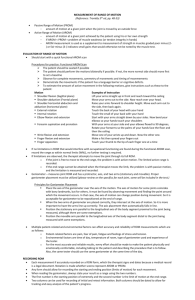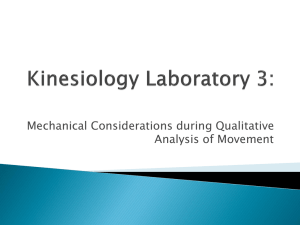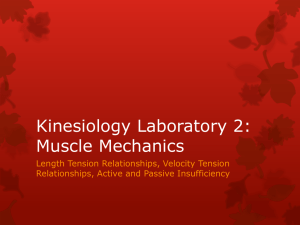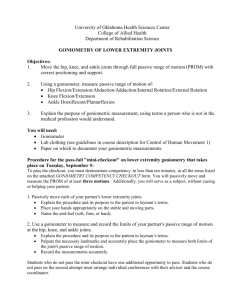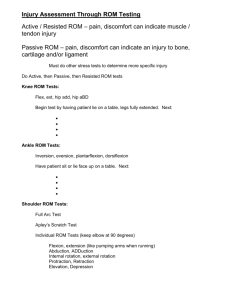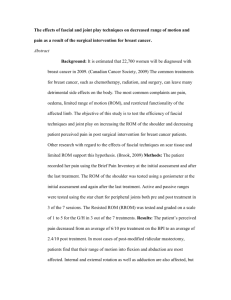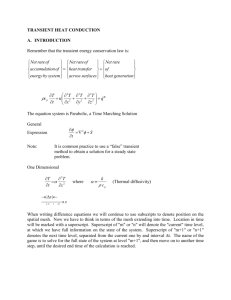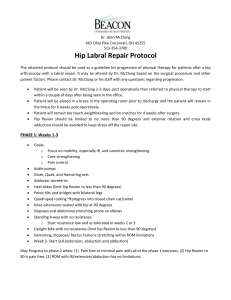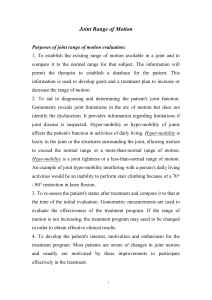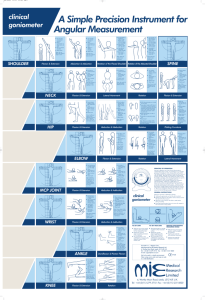Joint Range of Motion Data Using a Goniometer
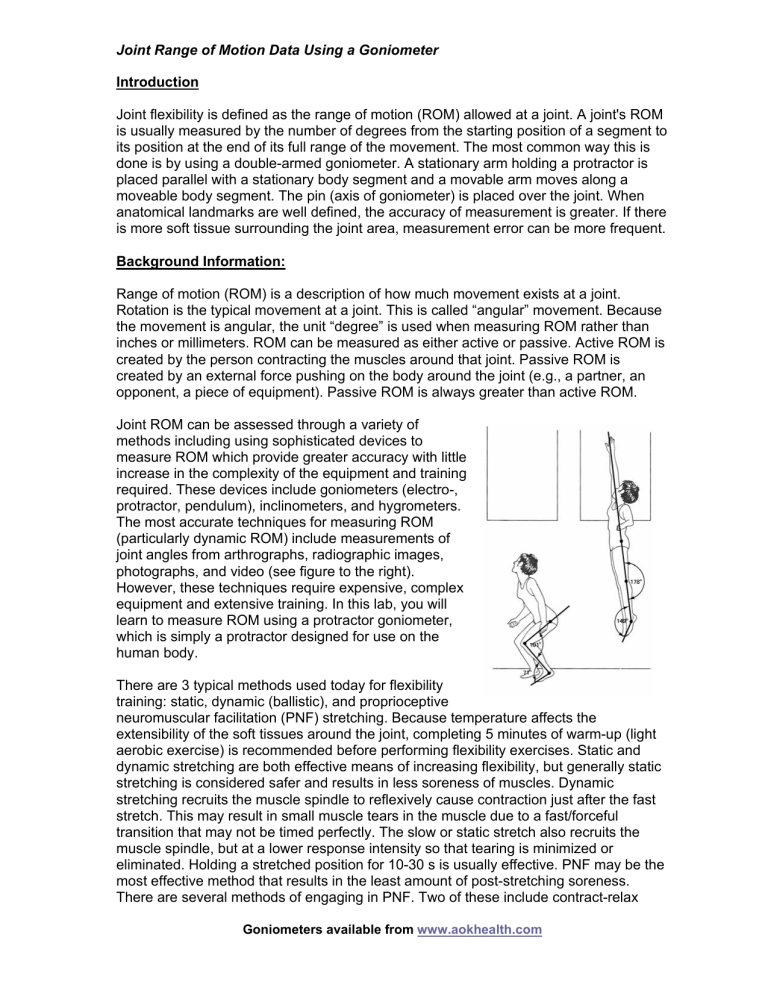
Joint Range of Motion Data Using a Goniometer
Introduction
Joint flexibility is defined as the range of motion (ROM) allowed at a joint. A joint's ROM is usually measured by the number of degrees from the starting position of a segment to its position at the end of its full range of the movement. The most common way this is done is by using a double-armed goniometer. A stationary arm holding a protractor is placed parallel with a stationary body segment and a movable arm moves along a moveable body segment. The pin (axis of goniometer) is placed over the joint. When anatomical landmarks are well defined, the accuracy of measurement is greater. If there is more soft tissue surrounding the joint area, measurement error can be more frequent.
Background Information:
Range of motion (ROM) is a description of how much movement exists at a joint.
Rotation is the typical movement at a joint. This is called “angular” movement. Because the movement is angular, the unit “degree” is used when measuring ROM rather than inches or millimeters. ROM can be measured as either active or passive. Active ROM is created by the person contracting the muscles around that joint. Passive ROM is created by an external force pushing on the body around the joint (e.g., a partner, an opponent, a piece of equipment). Passive ROM is always greater than active ROM.
Joint ROM can be assessed through a variety of methods including using sophisticated devices to measure ROM which provide greater accuracy with little increase in the complexity of the equipment and training required. These devices include goniometers (electro-, protractor, pendulum), inclinometers, and hygrometers.
The most accurate techniques for measuring ROM
(particularly dynamic ROM) include measurements of joint angles from arthrographs, radiographic images, photographs, and video (see figure to the right).
However, these techniques require expensive, complex equipment and extensive training. In this lab, you will learn to measure ROM using a protractor goniometer, which is simply a protractor designed for use on the human body.
There are 3 typical methods used today for flexibility training: static, dynamic (ballistic), and proprioceptive neuromuscular facilitation (PNF) stretching. Because temperature affects the extensibility of the soft tissues around the joint, completing 5 minutes of warm-up (light aerobic exercise) is recommended before performing flexibility exercises. Static and dynamic stretching are both effective means of increasing flexibility, but generally static stretching is considered safer and results in less soreness of muscles. Dynamic stretching recruits the muscle spindle to reflexively cause contraction just after the fast stretch. This may result in small muscle tears in the muscle due to a fast/forceful transition that may not be timed perfectly. The slow or static stretch also recruits the muscle spindle, but at a lower response intensity so that tearing is minimized or eliminated. Holding a stretched position for 10-30 s is usually effective. PNF may be the most effective method that results in the least amount of post-stretching soreness.
There are several methods of engaging in PNF. Two of these include contract-relax
Goniometers available from www.aokhealth.com
Joint Range of Motion Data Using a Goniometer
(CR) and contract-relax antagonist contract (CRAC). Use of PNF terminology and definitions is confusing in the literature, and a full understanding of PNF theory is yet to be developed. However, it is currently believed that suppression of the stretch reflex and enhancement of the Golgi tendon reflex work to make this method effective. Thus, the PNF technique is designed to capitalize on the neurological mechanisms in the muscle and joint.
What is a Goniometer
A goniometer is a device used to measure joint angles or range-of-motion. In MSI prevention, a goniometer is used to measure range-of-motion (in degrees) of joints for either active or passive joint range. This is pertinent to functional reach and workplace design. Using a goniometer, an ergonomist can quantify posture, including measuring joint angles during performance of a task.
Knowing the joint angle associated with a task can help ergonomists to make more specific design recommendations or to compare worker posture before and after changes have been made.
A goniometer can also measure progress in return of range-of-motion during recovery.
A traditional goniometer is a protractor with extending arms. To use a goniometer:
(1) Align the fulcrum of the device with the fulcrum or the joint to be measured
(2) Align the stationary arm of the device with the limb being measured
(3) Hold the arms of the goniometer in place while the joint is moved through its range of motion
The degree between the endpoints represents the entire range-of-motion.
Important Tips
Stabilize the stationary portion of the body. This is the part of the body that is proximal
(closer to the midline of the body) to the joint you are testing. It is important that the patient does not move his body while moving the joint; this step isolates the joint movement for a more accurate measurement.
Look at the reading on the goniometer before removing it from the patient's body.
Ensure that you take an accurate reading of the degree of motion on the goniometer, and that you consistently use the same stationary and movable landmarks on the body when measuring, to ensure consistency. Be sure to record the range of motion for the joint.
Goniometers available from www.aokhealth.com
Joint Range of Motion Data Using a Goniometer
Shoulder Girdle Movements & ROM
Stand behind a subject who has removed clothing from the waist up. Palpate the inferior angle and the vertebral border of the scapula (Figure 1).
Shoulder Joint ROM
FIGURE 1. Scapula Movements
(Adapted from Luttgens & Hamilton, 1997)
FIGURE 2. Lateral Motion of the Scapula
(Adapted from Luttgens & Hamilton, 1997)
Goniometers available from www.aokhealth.com
Joint Range of Motion Data Using a Goniometer
Elbow Joint ROM
Figure 3. Medial & Lateral Rotation of the Shoulder
(Adapted from Luttgens & Hamilton, 1997)
FIGURE 4. Elbow Joint Motions
(Adapted from Luttgens & Hamilton, 1997)
Goniometers available from www.aokhealth.com
Joint Range of Motion Data Using a Goniometer
Wrist Joint ROM
Hip Joint ROM
FIGURE 5. Wrist Joint Motions
(Adapted from Luttgens & Hamilton, 1997)
FIGURE 6. Hip Joint Motions
(Adapted from Luttgens & Hamilton, 1997)
Goniometers available from www.aokhealth.com
Joint Range of Motion Data Using a Goniometer
Hip flexion
Starting position:
Subject lies supine upon a firm, flat surface with the opposite hip held in anatomical position. Knee should flexed maximally while performing the movement. Do not allow the pelvis to lift during the movement .
Goniometer placement:
Proximal point of proximal segment – lateral pelvis midline (pointing toward GH joint)
Approximate joint axis – greater trochanter of femur
Distal point of distal segment – lateral condyle of femur
Measurements to perform (record in Table 1):
Active hip flexion
Passive hip flexion
Active flexion
Passive flexion
Trial 1 Trial 2 Trial 3 Average of 2
Closest
Hip extension
Starting position:
Subject lies prone in anatomical position on a firm, flat surface. Subject should maintain contact of both iliac crests with the surface during measurement.
Goniometer placement:
Proximal point of proximal segment – lateral pelvis midline (pointing toward GH joint)
Approximate joint axis – greater trochanter of femur
Distal point of distal segment – lateral condyle of femur
Measurements to perform (record in Table 1):
Active hip hyperextension
Passive hip hyperextension
Trial 1 Trial 2 Trial 3 Average of 2
Closest
Active hyperextension
Passive hyperextension
Goniometers available from www.aokhealth.com
Joint Range of Motion Data Using a Goniometer
Knee Joint ROM
Ankle Joint ROM
FIGURE 7. Knee Joint Motions
(Adapted from Luttgens & Hamilton, 1997)
FIGURE 8. Ankle Joint Motions
(Adapted from Luttgens & Hamilton, 1997)
Summary
Improving joint flexibility is essential for injury prevention. On may increase joint flexibility (range of motion) by regular stretching. What are the factors affecting flexibility of a joint? Table 1 summarizes the average ROMs published. Compare your measurements with these values. Are they in similar ranges or not? If not, why?
References
Luttgens, K. & Hamilton, N. (1997). Kinesiology: Scientific Basis of Human Motion, 9th
Ed.
, Madison, WI: Brown & Benchmark.
Goniometers available from www.aokhealth.com
Joint Range of Motion Data Using a Goniometer
TABLE. 1 Average ROMs (Adapted from Luttgens & Hamilton, 1997)
Joint/Segment
Elbow
Forearm
Wrist
Shoulder
Shoulder w/ Abducted Arm
Hip
Extended Hip
Knee
Ankle
Cervical Spine
Lumbar-thoracic
Spine
Movement
Flexion
Hyperextension
Pronation
Supination
Extension (Dorsiflexion)
Flexion (Palmar flexion)
Radial Deviation
Ulnar Deviation
Flexion
Hyperextension
Abduction
Adduction
Internal Rotation
External Rotation
Horizontal Adduction
Horizontal Adduction
Flexion
Hyperextension
Abduction
Adduction
Internal Rotation
External Rotation
Flexion
Plantar flexion
Dorsiflexion
Flexion
Hyperextension
Lateral Flexion
Rotation
Flexion
Hyperextension
Lateral Flexion
Rotation
Source
1*
40
50
150
20
30
60
75
45
80
45-50
25
25
30
90
-
-
100
30
40
20
30
180
50
180
50
90
140
0
80
80
60
60
20
Source
4*
40-45
45
130
50
20
40
40
45
50
45
20-35
30
45
90
135
45
120
30
45
0-25
30
180
60
180
-
60-90
145
0-10
80
90
50
60
20
Source
3*
45
45
140
-
-
-
45
20
-
-
-
-
-
70
-
-
125
10
45
10
35
130
80
180
-
70
145
0
90
90
70
-
20
Source
2*
35
45
120
-
-
-
45
15
-
-
-
-
-
90
-
-
120
10
45
-
30
170
30
170
-
90
145
0
90
85
70
90
20
Goniometers available from www.aokhealth.com
